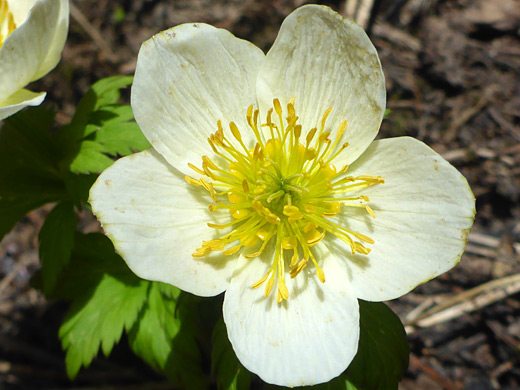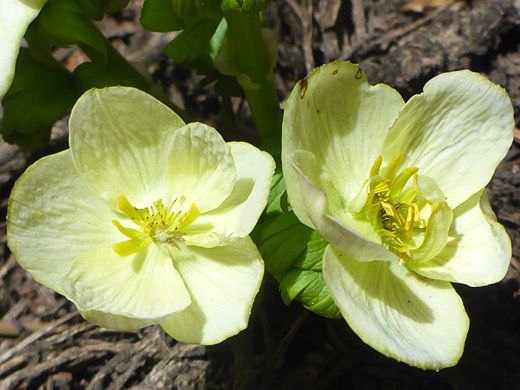Trollius Albiflorus, American Globeflower
Plants > Wildflowers > Ranunculaceae > Trollius Albiflorus
Common names:
American globeflower, western globeflower, white globe-flower
Family:
Scientific name:
Trollius albiflorus
Synonym:
Trollius laxus ssp albiflorus
Main flower color:
Range:
From Colorado to Washington
Height:
Up to 20 inches
Habitat:
Hillsides, meadows, open woodland; generally wet places, often with acidic soils; from 3,900 to 12,500 feet
Leaves:
Palmately divided into sharp-toothed lobes. Basal leaves have stalks up to 10 inches; the few stem leaves are stalkless
Season:
June to July
Trollius albiflorus has between one and three stem leaves, alternately arranged, clasping or short-stalked, plus a few at the base, attached by slender stalks of up to 10 inches. Leaves are hairless, partially divided into three or five lobes, each further divided, or toothed. Stems are thick, grooved, and hairless.
The large flowers, up to 2 inches across, are solitary, at the tip of the stem; they have between five and nine white sepals, obovate to round, and between 15 and 25 tiny yellow petals, largely hidden beneath the cluster of stamens and carpels at the center; petals are about half the length of the stamens. The sepals become pale yellow or pale green as they start to wither, and then brown.
Plants in the West are sometimes considered a subspecies, trollius laxus ssp albiflorus; another subspecies, ssp laxus (now a separate species) is restricted to alkaline meadows in the northeastern US and Canada, and characterized by sepals that are pale yellow rather than white.
The large flowers, up to 2 inches across, are solitary, at the tip of the stem; they have between five and nine white sepals, obovate to round, and between 15 and 25 tiny yellow petals, largely hidden beneath the cluster of stamens and carpels at the center; petals are about half the length of the stamens. The sepals become pale yellow or pale green as they start to wither, and then brown.
Plants in the West are sometimes considered a subspecies, trollius laxus ssp albiflorus; another subspecies, ssp laxus (now a separate species) is restricted to alkaline meadows in the northeastern US and Canada, and characterized by sepals that are pale yellow rather than white.
All Contents © Copyright The American Southwest | Comments and Questions | Contribute | Site Map







